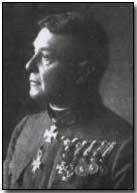Who's Who - Hermann Kovess von Kovesshaza
 Field Marshal Hermann
Kovess von Kovesshaza (1854-1924) served as a competent if unremarkable
Austro-Hungarian field commander whose career, close to retirement in 1914,
was given a second wind by the outbreak of war. He was
Austria-Hungary's final, entirely ceremonial, Commander-in-Chief.
Field Marshal Hermann
Kovess von Kovesshaza (1854-1924) served as a competent if unremarkable
Austro-Hungarian field commander whose career, close to retirement in 1914,
was given a second wind by the outbreak of war. He was
Austria-Hungary's final, entirely ceremonial, Commander-in-Chief.
With a career in imperial service behind him Kovess was due for retirement when war broke out in July 1914. He was nevertheless given command of XII Corps on the Eastern Front during the early stages of the war. Kovess took part in the Galician and Carpathian campaigns, as well as at Gorlice-Tarnow in mid-1915.
Appointed to command of Third Army as part of Army Group Mackensen (led by August von Mackensen) the highlight of Kovess' career was undoubtedly the capture of Belgrade on 9 October 1915.
Kovess' Third Amy entered Montenegro and Albania over the succeeding months and was moved to the Italian Front in time for the Austro-Hungarian Battle of Asiago of May 1916 (in which Austro-Hungarian Chief of Staff Conrad launched a full-scale offensive against the Italians during a pause in the interminable Isonzo battles).
Participating in the Battle of Asiago, Kovess found himself redeployed back to Galicia with news of the Russian Brusilov Offensive, leading Seventh Army from 20 October 1916.
Largely unaffected by the subsequent (and disastrously unsuccessful) Russian Kerenski Offensive, Kovess counter-advanced into Czernowitz in August 1917, whereupon he was promoted Field Marshal, ennobled and handed command of both Third and Seventh Armies in January 1918 (Army Front Kovess). His new command encompassed the Moldavian Front from the Dobruja to Galicia.
However with the agreement of the Russian Best-Litovsk treaty in March 1918 Kovess found himself without an active command until his appointment, on 3 November, as Austria-Hungary's final Commander in Chief. Given the disintegration of the Empire and Emperor Karl's recognition of national armies, Kovess' role was one without power.
With war over Kovess promptly retired from the army. He died in 1924.
A respirator was a gas mask in which air was inhaled through a metal box of chemicals.
- Did you know?
